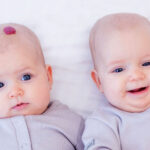Keeping up with the tween skin care trend: What’s in those products?

More teens and tweens are hitting the mall to grab skin-care products they’ve seen on social media — but are these popular ingredients safe for younger skin? We asked Dr. Jennifer Tan and Dr. Jennifer Huang in Boston Children’s Dermatology Program to weigh in on this trend and break down common ingredients.
Trends aren’t for everyone
Dr. Huang’s concern is that tween-aged shoppers are jumping on the skin-care trend without reading product labels or fully understanding how the ingredients work. “Like with anything else, skin care in moderation is healthy, and tweens need guidance in making educated choices when selecting the products that are best for them,” she explains. “You should have healthy skepticism of any product that is advertising that it will cure any skin condition.”
For example, skin care for younger children should be mostly focused on gentle cleansing, moisturizing, and sun protection. “Tweens and teens who have acne-prone skin can safely add acne-targeting cleansers and non-comedogenic (non-pore clogging) facial moisturizers to their skin-care routine,” she says.
But she raises caution about other products. “Anti-aging products have no place in tweens’ and teens’ skin-care routines,” Dr. Huang explains. “These products are not only expensive but are also often irritating and ineffective for this age group.” Both doctors also point out that early exposure to some popular skin-care ingredients can lead to skin allergies or sensitivities for young skin care enthusiasts.
Otherwise, most tweens and teens can safely add skin-care products to their routines, but they should do their research beforehand. “While some of the popular ingredients that we see trending aren’t harmful to young skin, they are frequently combined with fragrance or harsh preservatives that can irritate the skin. It’s best to use these products in moderation and introduce them gradually,” says Dr. Tan.
“The current trends offer a great opportunity to teach children to safely engage with skin care, though encouraging a simple routine that involves a gentle wash, sunscreen use, and a hydrating moisturizer is typically all that is needed for tweens and teens,” she adds.
Skin care ingredients to watch for
Below, Dr. Huang and Dr. Tan explain more about some of the ingredients commonly found in trending skin-care products. Before you start shopping, always be sure to talk to your dermatologist about adding new ingredients to your skin-care routine or to find out more information.
What is hyaluronic acid?
“Hyaluronic acid is a great moisturizing ingredient and promotes hydration,” Dr. Tan says. It retains water and helps add moisture to the very top layer of the skin — which can be useful for dry skin. “Hyaluronic acid is also suitable for acne-prone skin and sensitive skin,” she explains.
What is niacinamide?
Niacinamide is a topical form of vitamin B3 that has anti-inflammatory properties. “Niacinamide is calming on irritated skin, so this ingredient is often found in products for acne-prone skin and other skin conditions, like rosacea and seborrheic dermatitis,” says Dr. Tan.
Niacinamide can be safe for young people to use every day in a simple skin-care routine — but they should be aware of how much is in their products. “It’s always best to start on a low percentage and work your way to a higher percentage, just to make sure your skin can adjust,” explains Dr. Tan.
What is benzoyl peroxide?
Benzoyl peroxide has long been a powerhouse ingredient for treating acne in patients of all ages. It is a potent antibacterial agent that helps to reduce the development of pimples, as well as treat active acne.
However, one recent study found that benzene, a carcinogen, can form in products containing benzoyl peroxide when exposed to higher temperatures. Dr. Tan explains that while there has been no prior association with the use of these products and cancer, new data is needed to confirm the study’s results.
“In the meantime, we recommend avoid storing products containing benzoyl peroxide at high temperatures and using short-term contact with the skin (such as a face wash). Products that are exposed to excessive temperatures, or have reached their expiration date, should be thrown away,” she says.
At certain percentages, benzoyl peroxide can be irritating to sensitive skin, so if you’re concerned about a potential reaction, be sure to consult with your dermatologist before using.
The Food and Drug Administration (FDA) has recently responded to concerns raised by a 2024 study, which found that benzene, a carcinogen, can form in products containing benzoyl peroxide when exposed to higher temperatures. Dr. Tan explains that of the 95 products tested by the FDA, over 90 percent were found to have no or insignificant levels of benzene. In response to these findings, several skin care lines have voluntarily recalled their products, though the vast majority of benzoyl peroxide-containing products appear to be safe to use.
What are retinoids and retinol?
Retinoids and retinols are topical forms of vitamin A that help prevent breakouts, smooth skin texture, lighten dark spots, and minimize pore size. “They work as superficial exfoliants on the outer layers of the skin and help open and unclog pores,” Dr. Tan explains. “They can also preventive acne breakouts and help with pigmentation.”
While these ingredients are considered safe, tweens should only use them in moderation and if they are trying to treat acne. “Since retinol and retinoids can be very irritating and drying to some skin types, tweens and teens should speak to their doctors before introducing this ingredient, or any new ingredients, into their routines.”
For more, visit the Dermatology Program.
Related Posts :
-

Behind the mask: How to prevent and treat mask-related acne in children and teens
Wearing a mask is very effective at helping prevent the spread of COVID-19, but it can also trigger a host ...
-

Shining a light on the SPF gap: Why sun protection is so important for children of color
With summer just around the corner, it’s important to understand the risks that come along with those long, hot ...
-

What you should know about hemangiomas, according to a pediatric dermatologist
When parents discover that their infant has a hemangioma, a lot of questions usually follow. To find answers for the ...
-

Team spirit: How working with an allergy psychologist got Amber back to cheering
A bubbly high schooler with lots of friends and a passion for competitive cheerleading: On the surface, Amber’s life ...





